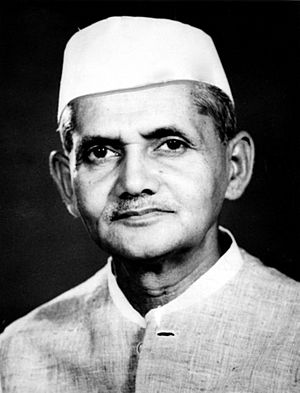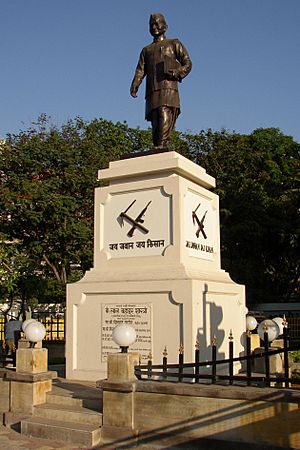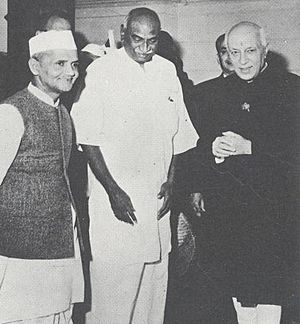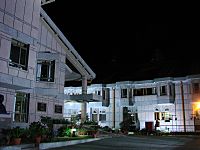Lal Bahadur Shastri facts for kids
Quick facts for kids
Lal Bahadur Shastri
|
|
|---|---|
 |
|
| 2nd Prime Minister of India | |
| In office 9 June 1964 – 11 January 1966 |
|
| President | Sarvepalli Radhakrishnan |
| Vice President | Zakir Husain |
| Preceded by | Jawaharlal Nehru |
| Succeeded by | Indira Gandhi |
| 3rd Minister of External Affairs | |
| In office 9 June 1964 – 18 July 1964 |
|
| Prime Minister | Himself |
| Preceded by | Gulzarilal Nanda |
| Succeeded by | Sardar Swaran Singh |
| 6th Minister of Home Affairs | |
| In office 4 April 1961 – 29 August 1963 |
|
| Prime Minister | Jawaharlal Nehru |
| Preceded by | Govind Ballabh Pant |
| Succeeded by | Gulzarilal Nanda |
| 3rd Minister of Railways | |
| In office 13 May 1952 – 7 December 1956 |
|
| Prime Minister | Jawaharlal Nehru |
| Preceded by | N. Gopalaswami Ayyangar |
| Succeeded by | Jagjivan Ram |
| Personal details | |
| Born |
Lal Bahadur Srivastava
2 October 1904 Mughalsarai, United Provinces of Agra and Oudh, British India (present-day Pt. Deen Dayal Upadhyaya Nagar, Uttar Pradesh, India) |
| Died | 11 January 1966 (aged 61) Tashkent, Uzbek SSR, Soviet Union (present-day Uzbekistan) |
|
Monuments
|
Vijay Ghat
|
| Political party | Indian National Congress |
| Spouse |
Lalita Shastri (m. 1928)
|
| Children | 6 |
| Alma mater | Mahatma Gandhi Kashi Vidyapith |
| Profession | Politician |
| Awards | Bharat Ratna (1966) (posthumous) |
| Nicknames | Man of Peace Nanhe |
Lal Bahadur Shastri (2 October 1904 – 11 January 1966) was an important Indian politician. He served as the second Prime Minister of India from 1964 to 1966. Before that, he was the sixth Home Minister of India from 1961 to 1963.
Shastri worked to improve India's food production. He supported the "White Revolution" to increase milk supply. He also started the "Green Revolution in India" in 1965. This helped India grow more food, especially in states like Punjab and Uttar Pradesh.
He was born in Mughalsarai and joined the Indian independence movement in the 1920s. He was inspired by leaders like Mahatma Gandhi. After India became independent in 1947, he became a key minister in the government.
Shastri led India during the Indo-Pakistan War of 1965. His famous slogan, "Jai Jawan, Jai Kisan" ("Hail to the soldier; Hail to the farmer"), became very popular. The war ended with the Tashkent Agreement in January 1966. He died the next day in Tashkent. He received India's highest civilian award, the Bharat Ratna, after his death.
Contents
Early Life and Education (1904–1920)
Lal Bahadur Shastri was born on 2 October 1904. He was born at his grandparents' home in a Kayastha family. His father, Sharada Prasad Srivastava, was a school teacher. His mother was Ramdulari Devi.
When Shastri was only 18 months old, his father died. His mother then moved with her children to her father's house in Mughalsarai. The family was later cared for by his great-uncle and then his cousin.
Shastri was a bright student. He received a good education, which was highly valued in his family. In 1917, his family moved to Varanasi. There, Shastri decided to drop his caste-based surname, "Srivastava."
Joining the Freedom Struggle (1921–1945)
Shastri was inspired by his teacher, Nishkameshwar Prasad Mishra. He became very interested in India's fight for freedom. He studied the lives of leaders like Swami Vivekananda and Mahatma Gandhi.
In January 1921, Gandhi asked students to leave government schools. He wanted them to join the non-cooperation movement. Shastri, who was almost finished with school, left to join the movement. He became a volunteer for the Congress Party. He was arrested but released because he was still a minor.
Shastri then joined the Kashi Vidyapith, a new national university. He graduated in 1925 with a degree in philosophy. He was given the title Shastri, meaning "scholar." This title became part of his name. He also worked to help the Harijans, a group of people who faced discrimination.
Shastri's Role in Independence
Shastri became an active member of the Indian National Congress in 1928. He was imprisoned for two and a half years for his activism. In 1940, he was jailed again for supporting the independence movement.
On 8 August 1942, Mahatma Gandhi launched the Quit India movement. This movement demanded that the British leave India. Shastri had just been released from prison. He traveled to Allahabad and helped guide activists from Jawaharlal Nehru's home. He was elected as a representative for United Provinces in 1937 and 1946.
Political Career (1947–1964)
After India gained independence in 1947, Shastri began his government career.
State Minister
He was appointed Parliamentary Secretary in his home state, Uttar Pradesh. He became the Minister of Police and Transport in 1947. As Transport Minister, he was the first to hire women conductors. As Police Minister, he ordered police to use water jets instead of lathis to control crowds. He also helped manage communal riots and refugee resettlement.
Cabinet Minister
In 1951, Shastri became the General Secretary of the All India Congress Committee. He played a key role in the Congress Party's success in the 1952, 1957, and 1962 elections. In 1952, he became the Minister of Railways and Transport. He later served as Minister of Commerce and Industry in 1959. In 1961, he became the Minister of Home Affairs.
Prime Minister (1964–1966)
Jawaharlal Nehru died in May 1964. Shastri became the Prime Minister of India on 9 June 1964. He was known for being mild-mannered and soft-spoken.
Domestic Policies
Shastri kept many of Nehru's ministers in his government. He appointed Indira Gandhi, Nehru's daughter, as the Minister of Information and Broadcasting.
His time as Prime Minister saw the Madras anti-Hindi protests in 1965. People in non-Hindi speaking states, especially Madras State, did not want Hindi to be the only national language. Shastri promised that English would continue to be an official language. This helped calm the protests.
Economic Policies and Food Security
Shastri continued to focus on India's economy. He promoted the "White Revolution" to boost milk production. He supported the Amul milk co-operative and created the National Dairy Development Board. He even stayed with farmers to understand their lives better.
During a time of food shortages, Shastri asked people to skip one meal a week. He did this himself first to set an example. Many people followed his "Shastri Vrat" (Shastri's fast). He also encouraged farmers to grow more food. He even ploughed the lawn at his official home.
On 19 October 1965, he gave his famous slogan, "Jai Jawan Jai Kisan" ("Hail the soldier, Hail the farmer"). This slogan became a national motto. He also promoted the "Green Revolution in India" in 1965. This led to a big increase in food grain production, especially wheat. His government also set up the Food Corporation of India.
Foreign Relations
Shastri continued India's policy of non-alignment. This meant India would not join any major power blocs. He also built stronger ties with the Soviet Union. After the Sino-Indian War of 1962, his government increased India's defense budget.
In 1964, Shastri signed an agreement with Sri Lanka. This agreement helped solve issues for people of Indian origin living there. In December 1965, he visited Burma and improved relations with its government.
War with Pakistan (1965)
Shastri's biggest challenge was leading India during the Indo-Pakistani War of 1965. In August 1965, Pakistani soldiers crossed into Indian territory. India responded by sending its forces across the border near Lahore. There were large tank battles in Punjab. Indian forces captured a key area in Kashmir.
The war ended on 23 September 1965 with a United Nations ceasefire. After the ceasefire, Shastri and Pakistani President Mohammed Ayub Khan met in Tashkent. They signed the Tashkent Declaration on 10 January 1966, formally ending the war.
Family Life
Shastri was a humble man. He was 5 feet 2 inches tall and usually wore a dhoti. He married Lalita Devi in 1928. They had four sons and two daughters. Many of his children and grandchildren have also been involved in public life.
Death and Legacy

Lal Bahadur Shastri died in Tashkent, Uzbekistan, on 11 January 1966. This was just one day after signing the peace treaty to end the 1965 war. Many of his supporters and family members have questioned the cause of his death. They believe there might have been foul play.
After his death, his wife, Lalita Shastri, claimed he was poisoned. The Indian government has not released much information about his death. This has led to many unanswered questions and conspiracy theories.
Shastri was known for his honesty and humility. He was not wealthy when he died. He owned an old car that he was still paying for. He believed in serving the people. He was the first railway minister to resign after a major train accident, taking moral responsibility.
He was a secular leader who believed religion and politics should be separate. He was awarded the Bharat Ratna after his death. A memorial called "Vijay Ghat" was built for him in Delhi. Many schools, institutes, and roads are named after him. The Varanasi International Airport is also named in his honor.
His ancestral home in Ramnagar has been turned into a museum. The Reserve Bank of India released 5-rupee coins to celebrate his birth century. An annual hockey tournament is also held in his name. A portrait of Shastri hangs in the Central Hall of the Parliament House of India.
Images for kids
See also
 In Spanish: Lal Bahadur Shastri para niños
In Spanish: Lal Bahadur Shastri para niños
- List of prime ministers of India
- List of unsolved deaths










